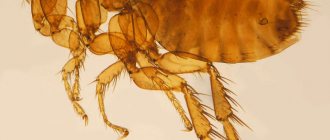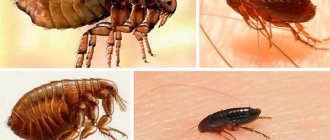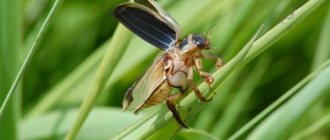How ticks live and bite
Ixodid ticks are specialized blood-sucking parasites of animals and humans, the largest representatives of the genus. In the warm season - from early spring to early autumn - it is they who begin the “hunt”.
Ticks are active and bite people and animals from spring to autumn
Many are convinced that ticks can only be found in forests, but this is not true. The parasite can be introduced into the urban environment with flowers, brushwood, and domestic animals (for example, dogs or cattle). There are known and not isolated cases of tick attacks in public gardens and parks. Ticks inhabit animal habitats, pastures, paddocks and wait for victims there. It is preferable for the parasite to hunt in bushes, grass and other low vegetation - this way it can easily and, most importantly, quickly climb onto the victim at the first favorable opportunity.
Having settled in ambush, the tick waits for the victim for quite a long time: in the spring, after winter hibernation, it begins to hunt; if there is no prey during the warm period, with the onset of cold weather it again goes “for the winter” until spring, after which it “wakes up” and continues to hunt.
A hungry tick can spend whole days, weeks and months waiting for a victim, falling into suspended animation during the winter.
Thanks to its well-developed sense of smell, it detects the approach of a potential host at a distance of up to 10 meters by earth vibrations, heat and smell. Having sensed “prey”, the tick, like antennae, extends its forelimbs forward in order to accurately grasp the direction of movement of the victim and latch onto it when it is nearby.
Once on the “host”, the mites spend a long time, sometimes for hours, searching for places of suction . Their oral organ has the appearance of a head sticking forward, adapted for cutting the skin and firmly and long-term fixation on the host’s body.
The tick does not bite immediately; it can spend 1–2 hours choosing the most tender place to bite
Thanks to the action of a natural anesthetic in saliva, bites are painless. Adult ticks suck blood from 1 to 12 days. The duration of the bite will be influenced by a number of factors: the developmental phase of the tick, gender, how long it will bite through the skin . These nuances are discussed in more detail below.
There is information that for the first 12 hours it pierces the skin and does not yet suck blood. But you should understand that this is inaccurate information, if only because the skin of a person has different thicknesses in different places, and in a child it will, in principle, be thinner than in an adult. Therefore, it is better to carry out inspections as often as possible.
After 1–2 days from the start of the bite, a feeling of slight nagging pain occurs, as a local inflammatory reaction develops at the site of suction, sometimes accompanied by suppuration. The bite wound heals slowly and is very itchy.
When parasite activity drops sharply
Ticks cannot tolerate cold frosty weather. During this period of time, which is winter, late autumn and very early spring, the likelihood of being bitten is completely eliminated.
Ticks cannot tolerate too hot weather. They hide in the shadows. But the whole paradox is that people are also looking for shade to hide from the heat. Therefore, rare cases of tick attacks are still recorded. Moreover, in hot weather, people want to take off their clothes, and they forget about precautions.
The number of parasites decreases sharply in the fall, but the chance of being bitten still remains.
Life cycle of a tick
The tick goes through several stages of development and changes through three hosts during its life.
The life cycle of a tick goes through four stages:
- Egg.
- Larva.
- Nymph.
- Adult: male, female.
Whether the parasite will go through all stages of development in one warm season depends on the following factors:
- successful “hunt” - the tick needs to change three hosts to move to the next stage of development;
- climatic conditions in the region - in the cold season the parasite slows down life processes and remains in suspended animation.
At all stages of development, ticks feed exclusively on the blood and lymph of animals and humans.
Larva
If the female tick is saturated with blood, then from late spring to early summer she will produce a clutch of 2-3 thousand eggs. After 2–4 weeks, larvae will appear.
The female tick lays eggs
The integument of the larvae's body has not yet been formed, the shell is thin and translucent, there are three pairs of limbs, however, already at this stage of development all the outlines of an adult are present.
The size of the larvae does not exceed 0.5 mm. It is difficult for them to climb to heights, so they have to hunt small terrestrial animals: voles, rats, hedgehogs. Having chosen a victim, the larva climbs onto it, attaches itself and begins to feed.
The duration of blood sucking of the moth is from 2 to 6 days, until complete saturation . A well-fed larva does not live on the host; at the end of the meal, it detaches and falls into the soil for further development. The stage of transformation into a nymph begins.
If at the end of the warm season the victim is not encountered, the tick will overwinter in the larval stage. Severe winters, frosts of -5°C and below can kill the larva. If the winter has been relatively warm, with the arrival of spring she will go hunting again.
A hungry larva, waiting for food, can live up to 2 years.
The life cycle of a tick lasts several seasons
Nymph
A nymph is an intermediate stage of tick development, something like a teenager, no longer a larva, but not yet an adult.
The parasite increases in size - the length now reaches from 1 to 2 mm, a pair of limbs is added - there are four of them, thanks to which the nymph moves much faster than the larva and can afford to hunt larger animals, for example, hares.
Already at the nymph stage, ticks show aggression towards humans; if they meet, they will try to attack him.
To quench the thirst of hunger, the nymph needs to “eat” from 3 to 8 days . After complete saturation, it becomes detached from the victim and disappears. With the help of drinking blood, a new stage of development begins - transformation into an adult.
Like the larva, the nymph can be destroyed by severe frosts, but if this does not happen, its hunt will continue in the spring. In a favorable environment, a nymph in a hungry state is viable for up to 2–3 years .
Adult
When sucking blood, the tick swells to gigantic size.
Ticks become males and females only in the adult stage. The size of a hungry parasite reaches 3–5 mm and directly depends on the sex of the individual—females are larger than males. The main goal of an adult tick is reproduction. Ticks hunt large animals and humans.
If a person is attacked by a tick, the duration of blood sucking will depend on the gender of the parasite. For high-quality egg laying and reproduction of healthy offspring, females need to pump 5–7 times more blood than males. Adult female ticks are capable of sucking blood for up to 12 days . The female’s body is designed in such a way that the hard shell only covers half of it; the other half is a kind of sac that can swell and contain an amount of blood that is 300–500 times greater than the tick’s own size. This is necessary for high-quality egg laying - only after fully “quenching her hunger” is the female able to lay eggs.
The male’s body is completely covered with a hard shell - it does not swell when sucking blood, and accordingly the amount of blood he drinks will be much less, and the “meal” will be modest and quick. The male tick drinks blood from 1 to 3 days .
Adults are quite hardy - severe frosts are unable to exterminate them; during the cold period they simply go into hibernation, and as the weather gets warmer they wake up and go hunting.
The external manifestation of the characteristics of the tick’s life cycle is the transformation of the body into a soft, voluminous bag that can stretch and swell when sucking blood.
Ticks do not use animals or humans as a permanent host to live and reproduce on them; they prefer the forest floor. They only need a sufficient portion of blood from the victim, upon receiving which they immediately detach . Cases of reproduction on the host are extremely rare. As a rule, ticks look for each other in natural conditions.
When saturated, the body of a female tick turns into a soft, voluminous sac.
The period of tick activity: when does it start and how long does it last?
Early melting of snow and persistent warm weather in March contributed to the early awakening of ticks.
The first tick bite last year was recorded on April 3, and in 2021 - on March 3 in the Chelyabinsk region. General tick activity is usually observed from April to October. When does tick season start? The onset of tick activity begins in April - May, when above-zero temperatures were recorded and the snow melted.
When does tick season end? The end of the season usually falls between September and October, when the weather is cool and damp. In 2021, the tick season ended in November, and this year it will end the same if there are no weather anomalies.
Are ticks active now? In the central region of Russia, Ukraine, the CIS countries and Europe, ticks emerged from hibernation and went in search of food, so they can pose a threat to humans and domestic animals.
The most favorable conditions for tick activity:
- Air temperature +18-20 degrees;
- 80% air humidity.
Typically, tick activity reaches its active phase in mid-April, it comes out of hibernation and begins to actively hunt and reproduce. In June, the population begins to decline due to dry and hot weather. The second wave of the activity phase occurs in August, September and sometimes October; it is weaker than the spring wave, but bites are just as likely. Warm autumn delays the tick's hibernation, and if the first frosts occur in September, the tick season can be considered over.
Have you been bitten by a tick? No, never 46%
Yes, once 46%
Yes, twice or more 8% Voted: 50
How many years do ticks live?
The main, and indeed the only, goal of this parasite, the simplest in structure, is to find a host, pump blood for further development, become an adult and continue the race. The female dies after laying eggs, the male dies after fertilizing 1-2 females . In a favorable year in a warm southern climate, ticks are capable of producing two offspring in one season. After reproduction they die.
Nature has endowed the tick with endurance - in conditions of famine and favorable climatic conditions, it is viable for up to 2-3 years.
The high fecundity of ticks compensates for the noticeable mortality caused by a shortage of hosts.
The influence of habitat on the life of a tick
Scientists have repeatedly confirmed that the lifespan of a tick depends on many indicators.
The parameters that influence the duration of existence of these arachnids include the following characteristics:
- species affiliation;
- climatic living conditions;
- ambient temperature;
- humidity level;
- availability of food.
Over millions of years of existence, these blood-sucking parasites have mastered various habitats.
To answer the question of how long a tick lives, you need to study the characteristics of representatives of individual species.
The Ixodid arachnid species, which lives in all regions of Russia, usually lives in forests and parks.
Ixodid tick
Under favorable climatic conditions and constant nutrition, this parasite lives up to 8 years.
The life cycle of individuals of the argas species can last up to 20 years. The duration of residence of argasid individuals increases if certain conditions are met: arachnids of this group love moisture, warmth and an abundance of food.
Argas miteMost often, these parasites inhabit dark areas located in the green forest zone, caves and grottoes.
Scabies mites have a short lifespan - no more than 2 weeks.
Scabies mite
These individuals cannot tolerate high humidity and low temperatures: such living conditions can kill arachnids that transmit scabies within a day.
It has not been proven how long a tick can live without food in an apartment. Some experts reduce the indefinite period to 9 months, subject to normal temperature and humidity - this is the period allocated to individuals transferred to an apartment.
This version is explained by the fact that in order to reproduce, blood-sucking parasites need forest litter, which is not available in isolated houses and apartments.
Existence after the bite
The lifespan of a tick depends on certain factors, including the availability of food and the characteristics of its habitat.
Tick bite site
It has been proven that ticks go without food for a long time, and in the absence of food in the form of blood, they fall into suspended animation and wait for the right moment to give the bloodsuckers a potential victim.
Females need more energy resources to satiate: by swelling to the size of a bean, the female can digest food for a week.
It takes the male 3 days to digest the food he receives. Thanks to a sedentary lifestyle and a special metabolism, some individuals, engorged with blood, can live for several years.
Having had their fill of blood, individuals of the ixodid species shed their chitinous cover and can live without food until the next renewal of the shell. Adult arachnids of this group live after feeding for up to 4-5 years, and for larvae this period is reduced to 2 years.
Argas adult parasites can use resources from one portion of blood for a long time.
Comparison of the sizes of a hungry and drunk tick
The larvae need more frequent feeding: they survive without blood for up to 2 years. After being bitten, they can survive for up to 7 years.
Many people are interested in the question: “How long can a tick live without food?” Most people don’t even realize what amazing endurance blood-sucking arachnids show, because they can live longer without food than without water. Factors including maintaining normal temperature and humidity for each species are more important than the constant availability of food.
Life expectancy without access to air
Another equally interesting question: “How long does a tick live without air?” also interests many people. Obviously, only anaerobic organisms can survive without access to air, and ticks, like all arachnids, need to breathe.
This fact does not negate the fact that blood-sucking parasites are very hardy, and the quality and duration of their life depends more on the characteristics of the air.
Most individuals love moisture and warmth; they feel most comfortable when air humidity exceeds 80%.
In summer, the number of bites decreases significantly: these blood-sucking parasites mainly go hunting in spring and autumn. If the season is hot and dry, the number of incidents with arachnid bites also drops sharply.
Conclusion
These arachnids do not like heat; they prefer a moderately warm environment that serves as cover: a clearing with tall grass or a scattering of bushes in the forest.
Ticks are carriers of dangerous diseases, so it is worth knowing that even a short-term presence of the parasite on the skin does not prove that infection has not occurred. You need to regularly check your clothes and inspect your body for bites.
Why is a tick dangerous?
When hosts change, conditions are created for the transfer of pathogens. The virus obtained from wild animals accumulates in the tick's body and penetrates the salivary glands. The duration of blood sucking directly affects the continued growth of the glands and the number of viral particles multiplying in them. With prolonged blood sucking, more viruses enter the blood, so if you find a tick on your body, it is important to immediately remove it and submit it to a laboratory to check for viruses .
Ticks are carriers of dangerous microbes and can transmit dangerous diseases, such as:
- borreliosis (Lyme disease);
- tick-borne encephalitis;
- tick-borne relapsing fever;
- ehrlichiosis;
- babesiosis;
- tularemia;
- spotted fever.
These diseases are dangerous for both animals and humans, as they can lead to disability and even death.
Among domestic animals, goats are the most susceptible to encephalitis. Human infection with tick-borne encephalitis virus can occur through raw goat milk.
Actions to take if bitten by a tick
Removal using tools
DIY devices are available in the form of plates with a teardrop-shaped hole and spoons or hooks with a V-shaped slot
The embedded tick must be pryed as deep as possible under the head and carefully pulled out using twisting and rocking movements. All tools are small in size, they can be used as key rings
Products available include Tick Twister and Trixie hooks, Ticked Off spoon, Pro-Tick and Tick Key plates.
What to do after extraction
If extraction was unsuccessful and the head remained under the skin, it must be removed with a disinfected needle. After extraction, in any case, the wound is treated with iodine, alcohol (vodka) or another disinfectant solution. The extracted tick must be submitted to a laboratory for testing. If an insect is removed in a medical facility, such a study is required. For greater safety, the extracted tick is placed in a plastic bag or glass flask (vial) with soaked pieces of paper.
Preventive actions
- repellent (repellent): Gall-RET, Deta-WOKKO, Biban, Reftamid maximum, Off! Extreme, DEFI-Taiga;
- acaricidal (killing): Reftamid taiga, Tornado-Antiklesch, Fumitox-anti-mites, Permanon, Piknik-Antiklesch, Gardex aerosol extreme;
- complex (repellent and killing): Kra-rep, Mosquito-anti-mite.
Correct actions will prevent a tick bite, and even if this happens, it will allow you to avoid serious consequences.
Prevention and treatment of tick-borne encephalitis
The main measure to prevent tick-borne encephalitis is vaccination with inactivated viruses. The standard regimen includes a course of three vaccinations. If living in an endemic area, it is necessary to be revaccinated every three years, otherwise – five years. Vaccination protects about 95% of those vaccinated.
If it is not possible to wait for two weeks for the formation of immunity, emergency prophylaxis with anti-encephalitis immunoglobulin is carried out. The protective effect occurs after a day, but lasts no more than a month. Immunoglobulin is also used to prevent encephalitis after a tick bite. The use of such a drug is likely to develop severe allergic reactions, so you cannot use it yourself.
Treatment of tick-borne encephalitis is carried out with gamma globulin titrated against the tick-borne encephalitis virus, or with serum immunoglobulin. Bed rest and balanced nutrition play an important role.
Types of ticks. Classification of ticks.
There are more than 40,000 species of ticks, which scientists have divided into 2 main superorders:
Description of the main types of ticks:
.
It is absolutely harmless to birds, animals and humans, since it is a complete “vegetarian” and feeds on plant juices, settling on the bottom of the leaf and sucking the juices out of it. It is a carrier of gray rot, which is destructive for plants.
It feeds on its relatives, so sometimes it is specially introduced by humans into greenhouses and hothouse farms to combat spider mites.
Granary (flour, bread)
mite
.
For humans, in principle, it is safe, but for grain or flour stocks it is a serious pest: the products become clogged with waste from the flour mite, which leads to its rotting and mold formation.
lives in the southern part of Russia, Kazakhstan, Transcaucasia, the mountains of Central Asia, and the south of Western Siberia. Mainly settles in forest-steppes or forests. Dangerous for animals and humans, it can be a carrier of encephalitis, plague, brucellosis, and fever.
harmless to humans, but dangerous to dogs. Lives everywhere. Particularly active in coastal areas and on the Black Sea coast.
Lifestyle and climate dependence
Spread across territories occurs due to the ability of pests to attack animals and birds. In this way, ticks find themselves at a significant distance from the hunting site. Most often, the form of tick parasitism is temporary. This means that pests spend most of their lives outside the body of their owner. They live in the top layer of soil, leaf cushion, and on low plants. The duration of one meal can be 1-3 weeks. Then the pest leaves the host on its own.
Life expectancy, growth rate of ticks, as well as the need for food - all these factors are determined by environmental conditions. Ticks are active when it gets warmer (the temperature at which pests wake up is +1°C), but an increase in temperature to +30°C can cause all functions to slow down. Life expectancy increases in cool climates.











